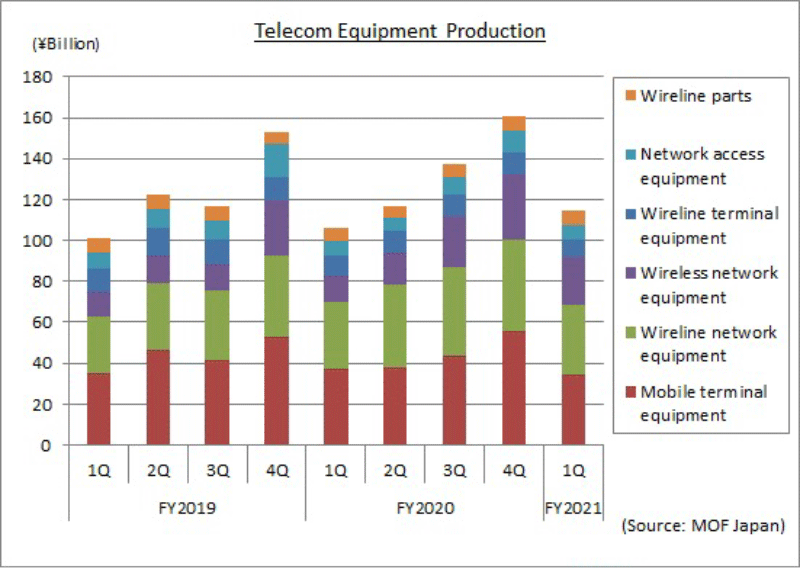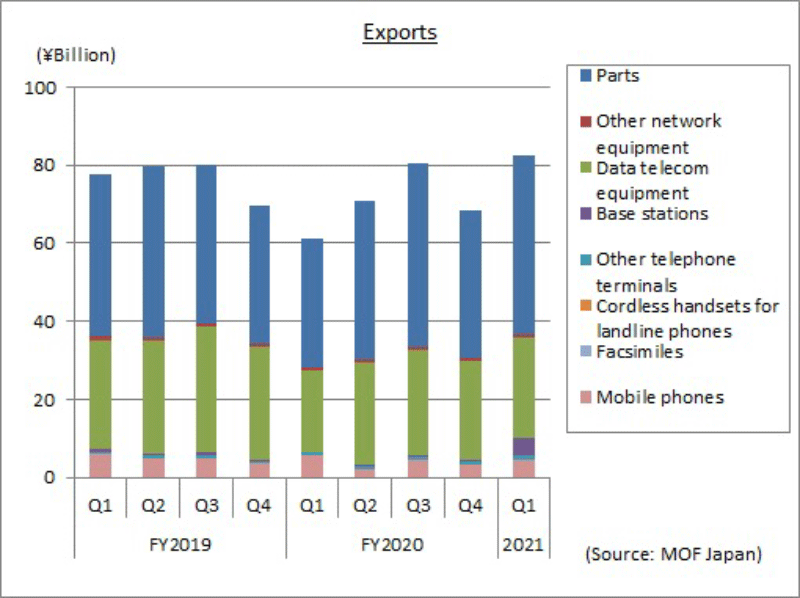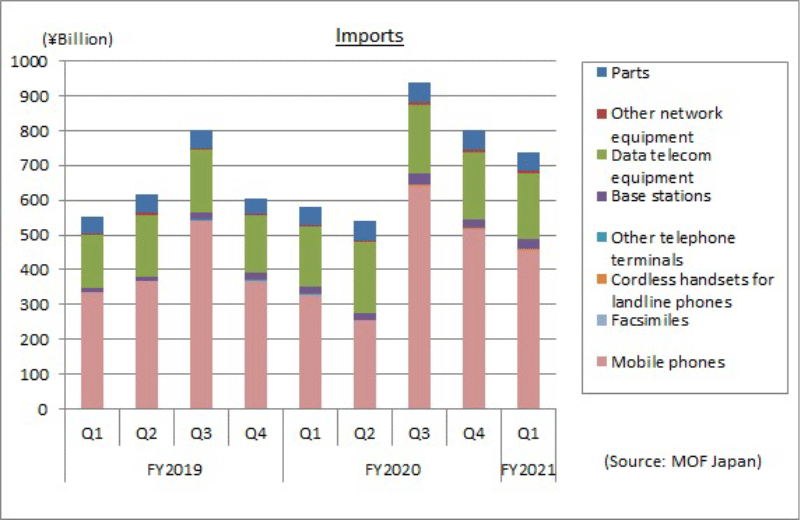I. Summary
In the April-June quarter of FY2021, the Japanese economy recorded an annualized quarter-over-quarter real GDP growth of 1.3% (first preliminary estimate released on August 16), turning positive after two quarters of negative growth. Private consumption also turned upward after two quarters due to recovering appetite for spending although consumption of services in the restaurant business remained weak, affected by people’s refraining from going out. Corporate capital expenditures increased as well, backed by steady corporate activities centered on major manufacturing companies which have seen strong exports to the U.S. and China that are on the way toward recovery from the COVID-19 pandemic.
Amid these circumstances, capital expenditures in the telecom market in the period from April through June 2021 were low for business-related devices such as key telephones and PBXs due to stagnant order receiving activities and installation work due to the deteriorated performance of small and medium-sized companies affected by the COVID-19 pandemic and the shortage of semiconductors. In addition, capital expenditures related to wireline network for the nationwide development of an optical cable network including the GIGA School Initiative have reached a certain phase of completion. However, demand for mobile phones, which decreased during the COVID-19 pandemic, began recovering due to newly released smartphones compatible with 5G (fifth-generation mobile communication systems) and sales promotion for the replacement of 3G models. Further, investment in base stations for the construction of 5G communications infrastructure continued to expand, while base station exports began and are increasing for the global business deployment of 5G.
(1) Domestic Market Trends
The value of the domestic market (value of domestic production – value of exports + value of imports; excluding parts) amounted to 755.0 billion yen in the April through June period, a year-on-year increase of 26.1%. This resulted from an increase in both the production and import of mobile phones and base stations, attributable to the advancing shift to 5G telecommunication.
(2) Domestic Production Trends
Domestic production totaled 114.3 billion yen in the April through June period, a year-on-year increase of 7.9%. Because demand for base stations for 5G communication has begun to increase in earnest, among other reasons, domestic production increased for three consecutive quarters.
(3) Export Trends
Total exports amounted to 82.6 billion yen for April through June, a year-on-year increase of 34.7%.
Exports to Asia, Europe and the U.S. were strong, in particular, demand for parts for the production of smartphone in China, of which production dropped sharply in the same quarter of the previous year, recovered to the level in the fourth quarter of FY2018.
(4) Import Trends
Total imports amounted to 737.6 billion yen in April through June, a year-on-year increase of 26.9%. Due to recovering domestic demand, demand for base stations and data communication equipment in addition to smartphones made by domestic and overseas manufacturers was strong, resulting in an increase for three consecutive quarters.
II. Domestic Market Trends
(Aggregated by CIAJ based on Indices of Industrial Production and Trade Statistics of Japan)
(1) Detailed trends by category
Actual figures for April through June by category are as follows. Due to the significant growth of terminal equipment and the continued steady performance of network equipment, an increase for three consecutive quarters was achieved.
Terminal equipment :
497.4 billion yen (+33.6% over the same period of the previous year)- Network equipment :
257.6 billion yen (+13.7% over the same period of the previous year)
The size of the domestic market (including the value of imports of foreign brands) was calculated using the government figures in the Indices of Industrial Production and Trade Statistics of Japan, according to the following formula: Domestic market size = value of domestic production – value of exports + value of imports
III. Domestic Production
(Aggregated by CIAJ based on Indices of Industrial Production compiled by the Ministry of Economics, Trade and Industry)
(1) Detailed trends by category
Actual figures for April through June by category are as follows.
Wireline terminal equipment
8.4 billion yen (-17.5% over the same quarter of the previous year). Of this, telephone sets was 0.4 billion yen (-4.4% over the same quarter of the previous year), key telephones 3.3 billion yen (+3.5%), and intercoms 4.7 billion yen (-28.3%). Because production of key telephones decreased due to the COVID-19 pandemic in the same quarter of the previous year, a year-on-year increase was posted. Equipment for small and medium-sized companies decreased reflecting restrained capital expenditures amid the COVID-19 pandemic, while equipment for telecommunications carriers increased due to demand for the updating of equipment. Production fell due to difficulty in the procurement of parts.
Mobile terminal equipment
34.7 billion yen (-7.2% over the same quarter of the previous year). Of which, mobile phones were 25.1 billion yen (+5.4% over the same period of the previous year). Mobile phones increased partly due to measures to promote replacement from 3G equipment, but other land telecommunication devices including commercial radio terminals and maritime and aeronautical mobile communications equipment experienced a reactionary decrease due to replacement demand in the same quarter of the previous fiscal year. As a result, total production declined.
Wireline network equipment
33.9 billion yen (+3.8% over the same quarter of the previous year). Of which, central office switching systems were 3.6 billion yen (+47.5% over the same quarter of the previous year), PBXs were 0.5 billion yen (-31.5% over the same quarter of the previous year), digital transmission equipment was 15.9 billion yen (+8.6% over the same quarter of the previous year) and other transmission equipment was 12.5 billion yen (-7.4% over the same quarter of the previous year). Demand for PBXs decreased because demand from small and medium-sized companies whose performances were hit by the pandemic were affected by the postponed upgrade of equipment and the deferred introduction of equipment, and also major companies reexamined their upgrade plans for work-style reforms and new communication styles. Further, the shortage of semiconductors impacted the receiving of orders. In central office switching systems, demand for the accommodation and conversion equipment that is necessary for the transition from public switched telephone networks to IP networks was maintained. Digital transmission equipment increased year on year as a reaction to a decline of production in the same quarter of the previous year due to the COVID-19 pandemic, but there was a demand decrease attributable to the somewhat settling capital expenditures for the increasing network volume due to teleworking and the nationwide development of an optical cable network for the GIGA School Initiative.
Wireless network equipment
23.3 billion yen (+86.2% over the same quarter of the previous year). Of which, fixed telecommunication devices were 3.9 billion yen (-22.1% over the same quarter of the previous year) and base station equipment was 19.4 billion yen (+158.2% over the same quarter of the previous year). Exports of terrestrial fixed telecommunication devices increased, but because satellite fixed communication devices for government offices and the private sector significantly decreased, domestic production declined. Domestic production of base station communications equipment is increasing significantly for the construction of 5G communication infrastructure.
Network access equipment
7.1 billion yen (+3.9% over the same quarter of the previous year). Routers for government offices and telecommunications carriers decreased, but both routers and LAN switches for the private sector were recovering from previously-restrained investment affected by the pandemic, while extended installation work was resumed. As a result, demand increased, leading to an increase in domestic production.
Wireline parts (relays and repeaters for wired equipment)
6.9 billion yen (+8.8% over the same quarter of the previous year). Domestic production increased for two consecutive quarters because of a recovery in parts used in the production of smartphones, which are mainly exported to Asia.
IV. Exports
(Compiled by CIAJ, based on Ministry of Finance’s “Trade Statistics”)
(1) Detailed trends by category
Actual figures for April through June by category are as follows.
Telephone sets and terminal equipment
5.5 billion yen (-13.0% over the same quarter of the previous year).
Of this, mobile phones were 4.3 billion yen (-21.9% over the same quarter of the previous year), cordless handsets for landline phones were 0.04 billion yen (-44.4% over the same quarter of the previous year), and other was 1.2 billion yen (+55.1% over the same quarter of the previous year). Exports of simple radio telecommunication devices, among other products, included in the other category to the U.S. increased, reflecting a rise in stay-at-home demand.Network equipment
31.3 billion yen (+44.0% over the same quarter of the previous year).
Of this, base stations were 4.6 billion yen (+1,898.9% over the same quarter of the previous year), data communication equipment was 25.9 billion yen (+23.8% over the same quarter of the previous year) and other network equipment was 0.8 billion yen (+42.4% over the same quarter of the previous year). Demand expanded due to economic recovery in Asia, Europe and the U.S., causing exports to increase. Because of the global business deployment of 5G communication, exports of base stations to the U.S. significantly increased.Parts (both wireline and wireless)
45.7 billion yen (+37.6% over the same period of the previous year).
Due to recovering demand for parts for smartphone production, which dropped sharply in China in the same quarter of the previous year, exports of parts significantly increased year on year.
(2) Detailed trends by region
A breakdown of results for April through June by region shows that Asia was 54.5 billion yen (+53.0% over the same quarter of the previous year), of which China was 27.3 billion yen (+192.9% over the same quarter of the previous year). North America was 18.9 billion yen (+9.2% over the same quarter of the previous year), of which the U.S. was 18.6 billion yen (+8.6% over the same quarter of the previous year). Europe was 7.6 billion yen (+21.4% over the same quarter of the previous year), of which the EU was 5.8 billion yen (+24.9% over the same quarter of the previous year). Exports of parts for smartphone production to China and base stations for the U.S. significantly increased. Exports of mobile phones to the U.S. remained strong as well.
(3) Comparison and breakdown by region
| First: | Asia | 66.0% (+7.9% over the same period of the previous year) |
| Second: | North America | 22.9% (-5.4% over the same period of the previous year) |
| Third: | Europe | 9.2% (-1.0% over the same period of the previous year) |
| Other regions | 2.0% (-1.5% over the same period of the previous year) |
V. Imports
(Compiled by CIAJ, based on Ministry of Finance’s “Trade Statistics”)
(1) Detailed trends by category
Actual figures for April through June by category are as follows.
Telephone sets and terminal equipment
459.8 billion yen (+38.9% over the same period of the previous year).
Of which, mobile phones were 457.5 billion yen (+39.3% over the same quarter of the previous year), cordless handsets for landline phones were 1.0 billion yen (+46.0% over the same quarter of the previous year) and other was 1.2 billion yen (-27.6% over the same quarter of the previous year). Due to recovering domestic demand, demand for and imports of personal equipment such as mobile phones and cordless handsets for landline phones expanded .Network equipment
224.6 billion yen (+14.4% over the same quarter of the previous year).
This includes 30.3 billion yen for base stations (+54.6% over the same quarter of the previous year), 188.8 billion yen for data communication equipment (+9.7% over the same quarter of the previous year), and 5.5 billion yen for other network-related equipment (+20.0% over the same quarter of the previous year). Of data communication equipment, switching and routing equipment was 75.9 billion yen (-18.9%) and other data communication equipment (including transmission devices, communication devices and modems) was 112.9 billion yen (+43.7%). Imports related to base stations for the development of 5G communication infrastructure increased significantly.Parts (both wireline and wireless)
53.3 billion yen (-1.3% over the same period of the previous year)
(2) Detailed trends by region
A breakdown of results for April through June by region shows that Asia was 698.5 billion yen (+27.9% over the same quarter of the previous year), of which China was 567.4 billion yen (+39.5% over the same quarter of the previous year). North America was 11.2 billion yen (-19.3% over the same quarter of the previous year), of which the U.S. accounted for 10.3 billion yen (-22.4% over the same quarter of the previous year). Europe was 19.1 billion yen (+51.3% over the same quarter of the previous year), of which the EU was 18.4 billion yen (+51.2% over the same quarter of the previous year). In Asia, imports of base stations and other data communication devices, as well as mobile phones, increased. Europe recorded a significant rise in imports of base stations, and also showed an increase in other data communication devices and parts.
(3) Comparison and breakdown by region
| First: | Asia | 94.7% (+0.8% over the same period of the previous year) |
| Second: | North America | 1.5% (-0.9% over the same period of the previous year) |
| Third: | Europe | 2.6% (+0.4% over the same period of the previous year) |
| Other regions | 1.2% (-0.3% over the same period of the previous year) |
VI. Trends in Orders Received and Shipped
(1) Actual figures in April through June 2021
Total orders received and shipped by Japan-based CIAJ member companies in April through June amounted to 333.3 billion yen, up 3.5% from the same quarter of the previous fiscal year. Of which the total value of domestic shipments totaled 254.0 billion yen, a decrease of 6.6% over the same quarter of the previous year) and exports was 79.3 billion yen, an increase of 58.2% over the same quarter of the previous year). Domestic shipment of wireline terminal equipment grew supported by stay-at-home demand, but the domestic shipment of network equipment excluding mobile base stations fell, resulting in a year-on-year decrease. On the other hand, exports increased reflecting a significant increase in demand mainly in the U.S. and China which were recovering from the COVID-19 pandemic, resulting in a year-on-year increase in the total amount of orders received and shipped.
*CIAJ Statistics for orders received and shipped = orders received and shipped by Japan-based CIAJ member companies
(=value of domestic shipments + value of exports = value of domestic production + value of imports of products produced overseas)
(2) Trends by category
Actual domestic shipments and exports by category in April through June were as follows:
Wireline terminal equipment
109.2 billion yen (+18.0% over the same quarter of the previous year).
In the process of recovering from the COVID-19 pandemic, willingness to buy was increasing, including stay-at-home demand, resulting in a growth in demand for personal-use equipment such as cordless handsets for landline phones, intercoms, and personal-use facsimiles (including multifunctional machines). In particular, exports of personal-use facsimile machines significantly increased due to stay-at-home demand. In terms of business-use facsimile machines (including multifunctional machines), demand for non-hardware decreased because of an increase in teleworking due to a new wave of COVID-19 infections in Japan while demand for hardware increased. Exports also increased due to a drastic recovery of demand in China, Europe, and the U.S.Mobile terminal equipment
95.8 billion yen (-10.5% over the same period of the previous year).
The number of mobile phones shipped recovered to the level of two years ago due to the release of new 5G-compatible smartphone products and the promotion of replacement sales, while the amount of shipments decreased due to the lowered prices of 5G terminals and the expansion of low-end terminals for replacement sales .- Wireline network equipment
42.8 billion yen (-20.8% over the same quarter of the previous year).
Demand for business-use equipment such as key telephones and PBXs weakened because of major customers’ postponement of equipment upgrades and suspension of equipment introduction. As the shortage of semiconductors has impacted orders received, it is assumed that the upgrade cycle will be prolonged. The amount of equipment exported recovered, but the amount of shipments decreased. Digital transmission equipment and PON/MC decreased because capital expenditures have been slowed . - Wireless network equipment
68.7 billion yen (+23.3% over the same quarter of the previous year).
Demand for fixed telecommunication devices declined due to a significant decrease in satellite fixed telecommunication devices for government offices and the private sector. Domestic demand for and imports of base station communications equipment increased for the construction of 5G communication infrastructure, and exports also increased remarkably attributable to the global business deployment of 5G based on Open-RAN specifications. - Other network equipment
7.3 billion yen (+7.1% over the same quarter of the previous year).
Demand for routers for government offices and telecommunications carriers decreased, while demand for routers and LAN switches for the private sector increased along a recovery from restrained investing due to the COVID-19 pandemic. However, it is assumed that there will be an impact from future waves of COVID-19 infections and decreased supply caused by the shortage of semiconductors. - Communication equipment parts
9.6 billion yen (-57.5% over the same quarter of the previous year)




